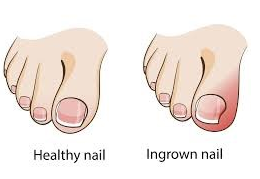

Consultant Plastic and Reconstructive Surgeon

Consultant Plastic and Reconstructive Surgeon

An ingrown toenail develops when the sides of the toenail grow into the surrounding skin. The big toe is most commonly affected either on one or both the sides. The nail curls and pierces the skin which usually becomes red, swollen and tender.
There are a number of things which can cause an ingrown toenail to develop, including:
If ingrown toenail is left untreated it can become infected. It is very important to:
Surgery is required if the toenail doesn’t improve. Surgery may involve removing part or all of your toenail depending on the severity of your symptoms.
Partial nail avulsion
Partial nail avulsion involves removing part of the toenail and is most commonly used operation for treating ingrown toenails. It’s about 98% effective.
A local anaesthetic is used to numb the toe and the edges of toenail are cut away. A course of antibiotics may be prescribed if your nail is infected, and any pus will be drained away.
Total nail avulsion
Total nail avulsion involves removing the toenail completely. This may be required if the nail is thick and pressing into the skin surrounding of toe.
After surgery
Toenail will be wrapped in a sterile bandage after the surgery. This will help to prevent infection. It is important to rest your foot and keep it raised for 1 to 2 days after the operation.
A painkiller such as paracetamol may be prescribed to help reduce the pain.
• Infection: any operation can be followed by infection which can be treated with antibiotics.
• Pain: ongoing discomfort is rare, but possible, following any surgery.
• Loss of function: you will have a temporary loss of function and things will be a little more difficult to do following surgery while the dressings are in place. In rare cases there may be a permanent loss of function.
a. Antibiotic ointment will be applied to the toe immediately after the procedure. The ointment is soothing and helps the toe to heal faster. You should apply the antibiotic ointment twice daily until the wound is completely healed.
b. You may shower the day after the surgery. Gently dry the area and apply antibiotic ointment after showering. Avoid baths, swimming, or soaking the toe for the next 2 weeks. Try to keep the toe clean and dry.
c. Your bandage will help to pad and protect the wound, while absorbing drainage from the wound. You can replace the bandage if blood or fluid soaks the bandage. Please keep the wound bandaged for at least 1 week after the surgery.
d. You may experience some pain after the procedure. If you do not have allergies, you can take ibuprofen, three 200-mg tablets 3 times a day with food, and paracetamol, two 325-500mg tablets every 4 hours.
e. You should wear loose-fitting shoes or sneakers for the first 2 weeks after the procedure. Please avoid wearing high-heeled or tight-fitting shoes in the future. You should avoid running, jumping, or strenuous activity for 2 weeks after the surgery. Teenagers should not participate in physical education activities for 1 to 2 weeks after the procedure.
f. Infection may develop in the toe during the first few weeks after the surgery. Call your doctor if you develop increasing pain, swelling, redness, or drainage from the toe.
g. Trimming the nails straight across the top of the nail is the best way to prevent another ingrown nail from developing. The nail must not be cut down into the corners, or picked at, or torn off. If you should develop another ingrown nail, see your doctor early, because early treatment may prevent the need for surgery.
It is necessary to take care of feet’s to prevent foot problems such as ingrown toe nail. It is necessary to cut nails properly (straight across and not at an angle or down the edges). It is important to wash your feet regularly every day and dry them thoroughly and use a foot moisturiser.
Use shoes that fit you properly and which will help to ensure that your feet remain healthy.
Free video/face to face consultation
with consultant plastic surgeon
Please fill in your details and we will get back to you.